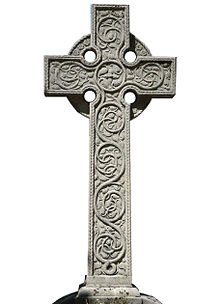Celtic cross

This article needs additional citations for verification. (April 2008) |
A Celtic cross is a symbol that combines a cross with a ring surrounding the intersection. The symbol is associated with Celtic Christianity, although it has older, pre-Christian origins. Such crosses form a major part of Celtic art. A standing Celtic cross, made of stone and often richly ornamented, is called a high cross or Irish Cross.
History

In Celtic regions of Ireland and later in Great Britain, many free-standing upright crosses (or high crosses) were erected by Irish monks, beginning at least as early as the 7th century. Some of these 'Celtic' crosses bear inscriptions in runes. There are surviving free-standing crosses in Cornwall (famously St Piran's cross at Perranporth) and Wales, on the island of Iona and in the Hebrides, as well as the many in Ireland. Other stone crosses are found in the former Northumbria and Scotland, and further south in England, where they merge with the similar Anglo-Saxon cross making tradition, in the Ruthwell Cross for example. The most famous standing crosses are the Cross of Kells, County Meath, Ireland, Ardboe Auld Cross, Ardboe, County Tyrone, Northern Ireland, the crosses at Monasterboice, County Louth, Ireland, and the Cross of the Scriptures, Clonmacnoise, Ireland. This representation is often related to the numerous representation of crosses combined with a circle before Christianity. Often called "sun cross", they can be found in Bronze Age Europe (Nordic Bronze Age, Urnfield culture). But there is a constant difference: only the Christian cross shows arms outside the circle, while the sun cross is totally surrounded by its circle. Moreover, the sun crosses are sometimes made with more than four arms. The archaic English word for cross as an instrument of torture is rood (literally "pole", cognate with rod). The word cross in English derives only indirectly from Latin crux via Old Irish and possibly Old Norse, introduced in the 10th century.
Celtic crosses may have origins in the early Coptic church. The similarity between the ankh, symbol of "life" and variations of the cross or ankh with a circle on Coptic stella and textiles from as early as the 5th century clearly show that the combination of circle and cross were used in early Christian Egypt. [1] Although some experts say that they were originally carved horizontally on stone, their Geometrical ring construction and the fact that the lights in east-facing high crosses can be seen to refract early morning sunlight is indicative of vertical construction.
In Ireland, it is a popular myth that the Celtic cross was introduced to the island by Saint Patrick or possibly Saint Declan during his time converting the pagan Irish. It is believed that Saint Patrick combined the symbol of Christianity, a cross, with the symbol of the sun (or possibly the moon), to give pagan followers an idea of the importance of the cross by linking it with the idea of the life-giving properties of the sun.[2]
After the 15th century, ringed crosses ceased to be created in the Celtic lands, other than a very few obscure examples, until the Celtic Revival of the 19th century. In 1853 casts of several historical High Crosses were exhibited with great success at the Dublin Industrial Exhibition. In 1857, Henry O'Neill published Illustrations of the Most Interesting of the Sculptured Crosses of Ancient Ireland. These two events stimulated interest in the Celtic Cross as a symbol for a renewed sense of heritage. New versions of the High Cross quickly became fashionable cemetery monuments in Victorian Dublin in the 1860s. From Dublin the revival spread to the rest of the country and beyond. It was a result of the Celtic Revival that the ringed cross became an emblem of Celtic identity in addition to its more traditional religious symbolism. [3] Alexander and Euphemia Ritchie, working on the Isle of Iona in Scotland from 1899 to 1940 popularized the Celtic Cross in jewellery. [4] During the 19th century, the local government of Guildford placed a Celtic cross on the top of Hindhead on the site of a gibbet on Gibbet Hill, in order to dispel the local fear of bad spirits. This being a place of the relatively superstitious broomsquire, the local populace found solace in the symbol.
Contemporary usage
The vast majority of Celtic crosses today are made for personal use. This is a departure from medieval and Celtic Revival times when the symbol was more typically a public monument. The contemporary Celtic cross is popular in jewelry, T-shirts, tattoos, coffee cups and other items. It has also been used extensively as grave markers since its revival in the 1850s. Versions of the Celtic cross are used by the Northern Ireland national football team and the Gaelic Athletic Association.
